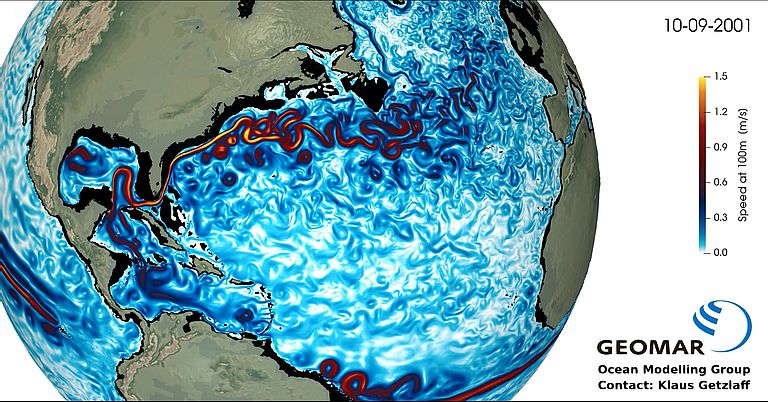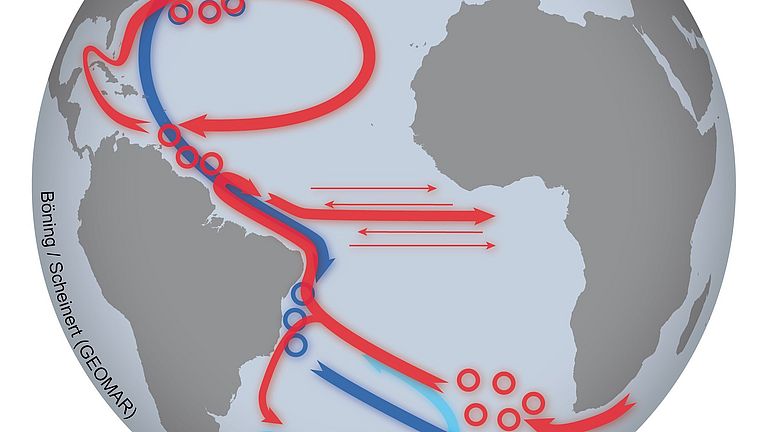New insights into changes of the Atlantic current system
Improved models and data help to understand the climate driver more precisely
Among the biggest climate driver worldwide are the powerful ocean currents that constantly circulate through the Atlantic Ocean. South and east of Greenland, cold water, heavy due to its high salinity, sinks to the deep ocean and moves southward. As a counter movement, warm water flows northwards from the tropics in the surface ocean. Experts call this circulation, which spreads across the entire ocean, the Atlantic Meridional Overturning Circulation (AMOC). The Gulf Stream, which brings heat from the Gulf of Mexico across the Atlantic to Europe and provides us with a mild climate, is part of this circulation. In the geographical latitudes where this conveyor belt moves particularly fast, it transports almost twenty times more water in one second than all the rivers in the world carry into the sea in the same time.
In an article in the scientific journal Nature Reviews Earth & Environment, a team of experts from Germany, Great Britain, France and the United States of America now shows that the strength of the North Atlantic circulation changes in a natural decadal rhythm. Their study is an important contribution to the much-discussed question whether the slowdown of the AMOC, which has been taking place since the late 1990s, can be attributed to human-induced climate change. Because water and associated heat transports are crucial for our climate, scientists around the world are very interested in this information. “Changes in the AMOC have been observed for some time. But the data were uncertain,” explains Professor Dr Arne Biastoch. The ocean modeller at GEOMAR Helmholtz Centre for Ocean Research Kiel is a co-author of the new study. “In the current publication, we have brought together findings of many different research studies, including many measurements and results from computer models.” The analyses show that the AMOC has weakened and strengthened repeatedly over the past decades. This appears to be mainly part of a natural change that recurs at the rate of several decades. “However, on the basis of the results so far, we are currently unable to identify whether there is already an underlying longer-term weakening. All climate models predict such a weakening for the future as a result of human-induced climate change,” Professor Biastoch emphasises.
At GEOMAR, a team led by Professor Biastoch has recently been working with the complex computer model VIKING20X, which simulates currents and hydrography in the Atlantic. It takes hundreds of parameters into account to represent the gigantic circulation in the North Atlantic. Because the representation would be affected even by a single incorrect parameter, the results of AMOC simulations were considered unreliable in the past. Today, thanks to greater computing power, they have a higher resolution and can thus incorporate more details: VIKING20X now calculates the AMOC on a grid of a few kilometres. In this way, even the numerous small eddies in which the gigantic current moves forward are captured. “It is enormously important to resolve the mixing of the water in these eddies in detail. Otherwise, the model will output inaccurate data about its speed and temperature,” Professor Biastoch explains. The quality of the computer codes and the growing amount of available input data in VIKING20X have also improved greatly.
A few months ago, the Kiel modellers published an article in the scientific journal Ocean Sciences based on the new, improved VIKING20X calculations. The results support the findings now described in Nature Reviews. “We are able to confirm with great certainty that the AMOC is subject to regular fluctuations,” says Arne Biastoch. The assumption that the AMOC has recently weakened mainly due to climate change that is currently being discussed among experts, cannot yet be verified with these calculations. “We are very cautious about making such a statement. Our work relates to the recent past. That's why it remains unclear for the time being whether the weakening due to climate change that all climate models predict for the future has already begun.”
To further improve the model simulations and the prediction of climate change-induced changes, Professor Biastoch and his team hope to obtain additional measured data on currents and hydrography from all regions of the Atlantic.
Publications:
Jackson, L.C., Biastoch, A., Buckley, M.W., Desbruyères, D.G., Frajka-Williams, E., Moat, B., Robson, J. (2022): The evolution of the North Atlantic AMOC since 1980. Nature Reviews Earth & Environment, https://doi.org/10.1038/s43017-022-00263-2
Biastoch, A., Schwarzkopf, F. U., Getzlaff, K., Rühs, S., Martin, T., Scheinert, M., Schulzki, T., Handmann, P., Hummels, R., and Böning, C. W. (2021): Regional imprints of changes in the Atlantic Meridional Overturning Circulation in the eddy-rich ocean model VIKING20X, Ocean Science, doi: https://doi.org/10.5194/os-17-1177-2021.
Animation:
Getzlaff, Klaus , Schulzki, Tobias und Schwarzkopf, Franziska U. (2022) Simulated near-surface speed combined with ice cover from VIKING20X simulation. DOI 10.3289/iAtlantic_VIKING20X_5day_2000_2009




